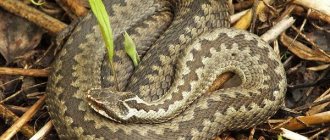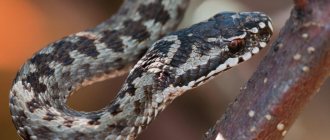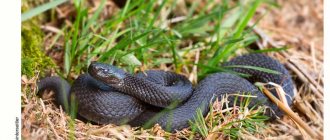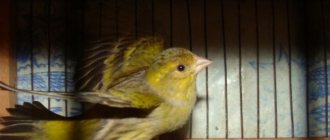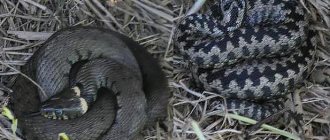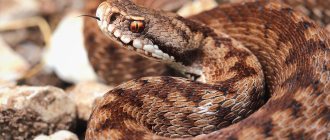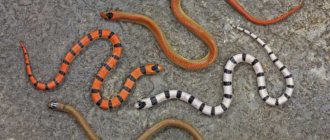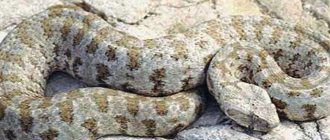- What do vipers eat in the wild?
If we take it on a global scale, then the viper is far from the most dangerous poisonous snake; it cannot compete with the same Asian
cobras, not to mention American rattlesnakes, which have an instant reaction and deadly poison, an unsuccessful encounter with which has a very high chance of becoming your last. But, nevertheless, among the reptiles that live in our latitudes, the viper is the most dangerous. Speaking of the name of this snake, the word “viper” goes back to ancient times and literally comes from the word “reptile”, which meant disgusting animals, which is the heroine of our article today.
Description, structure, characteristics
Many vipers have a short and thick body. The maximum length of a viper reaches 3-4 meters, while small snakes can be up to 30 cm long. The weight of an adult large viper is approximately 15-17 kg.
All species of vipers also have a flattened, rounded-triangular skull shape with noticeable temporal protrusions. At the tip of the muzzle of some species of this snake there are single or paired formations - the so-called modified scales.
The viper's eyes are small, have vertical pupils that can contract and expand, filling the entire eye. Thanks to this, vipers can see at night just as well as during the day; in general, the vision of these snakes is well developed.
The color of a viper can take on a variety of colors, depending on its species. Also on her body there can be a variety of simple patterns. But in any case, the colors of the viper depend on where it is located and are designed to blend in as much as possible with the surrounding space.
All vipers, however, like other poisonous snakes, have a pair of well-developed fangs, which are also devices for releasing poison. The latter is formed in the poisonous glands that are located behind the upper jaw of the snake. The teeth of a viper can be up to 4 cm in length. When the mouth is closed, they are folded and covered with a special film fabric.
During an attack or defense, the snake's mouth opens at an angle of 180 degrees, the jaw rotates, and the fangs extend forward. When the viper's jaws close, a sharp contraction of the strong muscles surrounding the poisonous glands occurs, resulting in the release of poison, which is more similar to a blow than a bite.
Habitat
The common viper inhabits the entire forest and taiga zone. It is found in the north (near Murmansk, Arkhangelsk, Central Yakutia, etc.); in the east (Sakhalin, Primorye, Amur region, etc.). The common viper is well known in many countries. There is a greater chance of meeting a snake in damp swampy places, in meadows and clearings with tall grass, in clearings, in raspberry thickets, on the banks of rivers (lakes), in haystacks, in burnt areas overgrown with grass and in abandoned gardens. Vipers are often seen while picking mushrooms and berries. These snakes are also found in mountainous areas (among stones and rocks) at an altitude of up to 3000 meters above sea level.
During the day, especially in the heat, vipers lie motionless, basking in the rays of the sun. To do this, they choose paths, stumps or dusty roads. They like cloudy weather less. The snake waits out this time in a shelter. The viper's peak activity occurs at night, when it hunts rodents, amphibians, and birds and eats their eggs. The usual food of vipers are frogs and voles.
The number of common viper in some regions (especially in the European part) is constantly declining. The common viper is included in the Red Book of the Moscow Region and a number of national lists. This happens for many reasons: catching and destroying snakes, changing the landscape (for example, reducing the area of swamps) and environmental problems. Vipers leave en masse places that are inhabited by people. In addition, vipers (especially their young) are readily eaten by badgers, foxes, wolves and martens. The worst enemies of vipers are hedgehogs. Birds also destroy large numbers of vipers. Herons, storks, crows, owls and even ducks feast on them. More often, vipers suffer from birds.
In addition to vipers, snakes were also found near the ditches. They say that snakes are at enmity with vipers and kill them. I have seen more than once how a grass snake and a viper lie side by side and calmly bask in the sun. And I never saw them fight. I saw vipers fighting among themselves. I was walking through a meadow one day and noticed that someone was moving the grass near a ditch. He came closer. I see two vipers fiddling around. One holds the frog by the head, the other holds the same frog by the side. I don’t know how their struggle would have ended. I didn’t wait for the end of the fight - I put both of them in a bag (A.D. Nedyalkov “Naturalist in Search”).
An interesting fact: each viper strives to have its own territory (with a radius of 60 - 100 meters in diameter). However, there are also snake hotspots that contain large numbers of snakes in a relatively small area. The common viper is an excellent swimmer. She uses her skill to move to the other side of a river or lake in search of suitable places to live. Around the end of September, vipers begin to move in search of wintering sites. Since ancient times, these days have been called “Shift,” when “snakes gather for the winter.” Vipers overwinter (often in groups) in burrows of small animals, under the roots of old rotten stumps, in deep cracks, etc. During this cold period, they fall into a state of torpor.
Nutrition
The viper is a notorious predator, and also leads a nocturnal lifestyle. These snakes prefer to attack their prey from an ambush, quickly biting it with their poisonous fangs; the poison kills the victim within a few minutes, then the viper begins its meal, usually swallowing the prey whole.
The main menu of the viper is a variety of small rodents,
lizards, marsh frogs, some birds. Small vipers feed on large beetles, locusts, and can catch caterpillars and butterflies.
I wonder what the viper eats?
It is obvious that the viper uses venom to kill prey. Who can she kill? Small rodents, or rather, voles and spindles. Vipers, being reptiles, essentially eat their relatives - small lizards and frogs. Small chicks of warblers and buntings that have fallen from the nest are common prey for this type of snake. Young vipers feed differently. It’s difficult to call their prey and prey - these are small bugs, caterpillars, ants. However, snakes that have not yet grown up are quite capable of eating even small insects.
Mating games of vipers
Enemies in nature
Vipers also have their own enemies, who, despite the presence of poisonous fangs, are not averse to feasting on this snake. Among them
foxes, ferrets, badgers, wild boars (surprisingly, viper venom does not affect wild boars at all), as well as a number of birds of prey: owls, herons, storks and eagles. Also among the enemies of vipers are hedgehogs, which, although they do not feast on them, often engage in fights with these reptiles, from which they usually emerge victorious.
How to protect yourself from a viper bite?
When going out into the forest, wear rubber boots (or any other high shoes) and thick, long trousers. Vipers cannot jump; the maximum height to which a snake can “reach” is 15 cm. When moving through the forest, especially in tall grass or bushes, make loud noise: stomp, talk. The viper wants to meet you no more than you want to meet it, and, having heard the noise of your movement, it will crawl away so quickly that you won’t even notice it.
Remember : snakes are not aggressive and only attack in self-defense; To provoke a viper bite, you must literally step on it.
If you're picking mushrooms or berries, take a stick with you and use it to stir up the grass before bending down to collect your prey. Do not sit on rotten stumps and fallen trees in the forest, do not turn over pieces of old bark lying on the ground, do not reach into hollows with your hands, try not to step on piles of litter and avoid areas with windbreaks. When you see a snake, do not approach it, even if it seems to you that it is just a harmless snake.
Poison - consequences of the bite and symptoms
The venom of a viper is not as potent as, for example, that of a cobra or a rattlesnake, but in some cases it can be fatal to humans. Therefore, it would not be amiss to remind you once again that you should stay away from the viper, as well as all poisonous snakes in general.
On the other hand, viper venom has found its use for medical purposes; a number of medicines are made from it, and it is also used in the production of cosmetics. According to its chemical structure, viper venom consists of proteins, lipids,
peptides, amino acids and salts and sugars of inorganic origin. Preparations from it help as a painkiller for neuralgia, rheumatism, hypertension, and skin diseases.
When bitten, the viper's venom enters the human body through the lymph nodes and from there instantly ends up in the blood. Symptoms of a viper bite: burning pain, there will be redness and swelling around the bite site, as a result of intoxication there will be dizziness, nausea, chills, rapid heartbeat. Needless to say, if you are bitten by a viper, you should immediately seek professional medical help.
Vipers of the Serpentine Glade of the Nurgush Nature Reserve
In August 2014, I visited the Nurgush nature reserve, but I never got around to examining the photographs taken there. Recently, while selecting shots for the photo competition “Reserves and National Parks of Russia are 100 Years Old,” I remembered several portraits of snakes from the reserve. In the security zone of the Nurgush nature reserve (the one where access to outsiders is allowed) there is a clearing in which many years ago, even before the formation of the reserve, there was a summer camp for livestock. The remains of which, in the form of a heap of rotten pieces of wood covered with lichen, can still be seen at the edge of the clearing. Snakes loved this place very much. Vipers bask in the sun on wooden debris, among which they can hide in case of danger. It is not surprising that this clearing was nicknamed Snake . Despite the fact that they look different, they are all one species - the Common Viper (lat. Vipera berus). Some of them are light gray in color, with a dark pattern on the back, some are completely black. This is a manifestation of melanism, excessive dark pigmentation. Vipers can be easily distinguished from harmless snakes by the absence of yellow spots on the back of the head, and if you get to know them very closely, the snake has a round pupil, while the viper has a vertical pupil, like a cat’s. But you shouldn’t be afraid of the viper either. For all its poisonousness, it prefers not to be seen by humans and hides at the first danger. Only when driven into a corner or taken by surprise does it hiss and rush threateningly. You should not consider your life over if the worst thing happens - you are bitten by a viper. Over the past half century, there have been almost no deaths from a direct viper bite (except if a small child was stung in the face), more from the consequences of improper treatment (cutting the wound, tightening it with a tourniquet, cauterizing it, and other nonsense). But more on this below.
What does a common viper look like?
This snake is 35-50 cm long. The common viper can be of different colors, but there is one distinguishing feature for all vipers: it is a dark zigzag on the back, from the back of the head to the end of the tail, which is accompanied on each side by a longitudinal row of dark spots. It can be assumed that the main color of vipers is silver, but this is conditional, since there are light gray, yellow, green and brown individuals. In some areas, up to 50% of the population are melanistic black vipers. The viper's abdomen is dark gray or even black. The end of the tail is always lighter in color, usually lemon.
The head at the back is noticeably wider than the neck, rather flat, the neck is clearly separated and slightly compressed laterally, the tail is relatively short, noticeably thinner in the last third of its length and ends with a short, hard tip. The male has a shorter and thinner body, and the tail is relatively thicker and longer than the female.
Vipers have large, round eyes. Some say that they reflect some kind of deceit and aggression. The color of the iris is usually bright fiery red; in dark females it is light reddish-brown.
Where do vipers live?
The common viper is distributed mosaically in the forest belt of Eurasia from Great Britain, France and northern Italy in the west, to Sakhalin and the Korean Peninsula in the east. In Eastern Europe, the viper sometimes penetrates the Arctic Circle - for example, it lives in the Lapland Nature Reserve and on the shores of the Barents Sea. To the east - in Siberia and the Far East - the distribution in many places is limited by the lack of suitable wintering burrows. From the south, the range is limited to steppe regions.
The viper does not have any special preferences in its habitat; it can be found here and there: in forests and deserts, in mountains, meadows, fields, swamps and even in the steppes. The main thing is that there is enough food and light, and for the rest it does not make any special demands. There are especially many vipers in swampy areas. Here they sometimes live in terrifying numbers.
The viper lives in some hole in the soil, under the roots of a tree or between stones, in a hole (from which it first drives the owners out), in a crevice in the soil - in general, in some similar shelter, near which there should be a small open place where it I could bask in the sun.
Lifestyle of the common viper
Vipers spend their entire lives (and they live twelve to fifteen years) in the same territory. Distribution is uneven depending on the availability of places suitable for wintering. The saddle, as a rule, does not move further than 60-100 meters. The exception is forced migration to a wintering place; in this case, snakes can move away to a distance of up to 2-5 km. In the summer, it sometimes basks in the sun, but mostly hides under old stumps, in crevices, etc. Despite the fact that vipers love light and warmth, it cannot be said that this snake leads a diurnal lifestyle; on the contrary, during the day they are slow, love to bask in the sun’s rays, and with the onset of dusk, vipers become active and crawl out to hunt. Even her eyes are adapted to seeing in the dark: the pupil can expand and contract, which is rare in reptiles.
Vipers feel great at a body temperature of nine to thirty degrees. If the temperature drops below nine or rises above thirty-five degrees, the animal dies. Therefore, the snake is forced to spend the whole day in the shelter, crawling out into the sun several times to bask.
Vipers overwinter in the soil at a depth below the freezing layer, climbing into burrows of moles and rodents, passages of rotten roots of trees and shrubs, deep cracks in rocks and other shelters. Sometimes they accumulate in one place in small groups. Torpor in vipers during hibernation lasts in central Russia for about six months.
The viper has many enemies in nature, for example, owls, foxes, hedgehogs, ferrets, minks and eagles. The greatest danger to the common viper comes from humans, primarily from their economic activities aimed at deforestation and other changes in natural landscapes. Among forest inhabitants, the main enemies of vipers are hedgehogs, which are immune to snake venom. The hedgehog uses the following tactics when attacking: it bites the snake on the body and immediately curls up into a ball, exposing its needles for a retaliatory strike. The procedure is repeated several times until the viper weakens and dies.
What does a viper eat?
The food for vipers consists mainly of warm-blooded animals, especially mice, which the snake prefers to any other food. From the observations of scientists it follows that it catches mice not only on the ground, but also underground. Chicks, especially those birds that nest on the ground, often become victims of the viper. It can also hunt adult birds. She eats frogs and lizards only as a last resort.
The viper lies in wait for its prey and bites it (for example, a forest mouse), and then releases it in order to later find the corpse along the trail, since under the influence of the poison that penetrates the wound, the bitten animal quickly dies.
Vipers are predators from birth. Young snakes catch insects - locusts, beetles, and, less commonly, butterfly caterpillars, ants, slugs and earthworms. In turn, vipers become victims of birds of prey and animals.
Viper breeding
The mating season is in May, and the offspring appear in August or September, depending on the climate. Mating begins only when spring weather has settled. The number of cubs produced by a female depends on the age of the mother: younger ones have five to six cubs, older ones have 12-14, even 16 cubs.
The viper is viviparous - the development of eggs and the hatching of cubs occurs in the womb. The intrauterine development of viper embryos is very interesting. The walls of the upper shell of the eggs are penetrated by blood vessels, so the embryo feeds on both the yolk of the egg and nutrients dissolved in the mother’s blood. It happens that during childbirth, the female wraps herself around a tree or stump, leaving her tail hanging, “scattering” the baby snakes onto the ground, which from the first moment begin an independent life. Juveniles are usually 15–20 cm long and are already poisonous. As they grow, they molt, leaving behind crawling out like snakes.
The Viper is born evil and remains evil for the rest of its life. The little vipers, just hatched from the eggs, hissed and bit angrily when touched. Immediately after birth, each little viper crawls away, and the mother does not pay any attention to the cubs.
Why is a viper dangerous?
Vipers are the most common venomous snakes in central Eurasia. Their bite is dangerous to humans, but not fatal. If a person is not allergic to snake venom, then the bite does not pose a threat to life.
This snake is not aggressive and when a person approaches, it tries to use its camouflage coloring as much as possible, or to crawl away. Only in the event of a person's unexpected appearance or provocation on his part can she try to bite him. This cautious behavior is explained by the fact that it requires a lot of energy to reproduce venom in conditions of changing temperatures.
The viper never attacks a person first; it bites only if it is pursued, grabbed with hands, or stepped on. At the sight of a person, the viper always hurries to crawl away, hide, or lies quietly.
When attacked, the snake curls up and pulls its neck into the middle of the resulting flat circle, so that with each bite it quickly extends it by 15, at most 30 cm. Retraction of the neck is always a sign that the viper wants to bite; immediately after the bite, it quickly retracts its neck again , preparing for the next attack.
When attacking, the viper focuses primarily on lightning speed, rather than accuracy. When attacking, she often misses, but immediately makes the next attempt until she achieves her goal. You have to be careful, as the viper never attacks silently. Even if it is hunting, the snake makes a loud hiss before attacking its prey. This hissing or snorting is made with her mouth closed and is caused by her inhaling and exhaling air more forcefully than usual. When air is exhaled, the sound is strong and low; when air is inhaled, it is weaker and higher.
The viper injects a small amount of poison into the victim. She saves it, since the production of poison is a very energy-intensive process and takes a lot of strength from the snake. The viper has hollow large fangs with a deep groove. The snake injects venom into the victim thanks to a reflex contraction of the temporal muscles that surround the venom-carrying glands.
What to do if you are bitten by a viper
Most often, bites from non-venomous snakes leave only small scratches on the body. The bite of a poisonous snake leaves deep punctures from the teeth, through which the poison is injected. When bitten, the poison can get under the skin, into muscle tissue or into the lumen of a victim’s vessel. A bite into the lumen of a vessel is more severe due to the fact that the poison spreads faster throughout the body causing various disorders. There may be cases when the bite occurs with one fang, as a result of which a smaller dose of poison is injected and the poisoning proceeds more easily.
The viper's venom is hemo- and cytotoxic, that is, it destroys blood and tissue. It contains hyaluronidase and phospholipase and destroys the walls of blood vessels, red blood cells, proteins, and forms blood clots inside the vessels, leading to poor circulation. In addition, the poison disrupts cardiac and liver function, and also disrupts water-mineral balance.
- Hyaluronidase - breaks down connective tissue, destroys the walls of small capillaries, increases tissue permeability to water and ions.
- Phospholipase – splitting the lipid layer of red blood cells leads to their destruction (hemolysis of red blood cells).
The above enzymes increase the permeability of cell membranes (mast cells) containing biological active substances (histamine, heparin, etc.), which leads to their release and the manifestation of inflammatory and allergic reactions (swelling, redness, pain, itching).
For humans, the bite of a common viper is considered potentially dangerous, but it is extremely rarely fatal. For example, in the UK, only 14 deaths were recorded between 1876 and 2005, the last of which occurred in 1975 (a five-year-old child died from a bite). About 70% of those bitten either experience no symptoms at all or feel a burning pain directly in the area of the bite. Often, redness and swelling develop around the wound - hemorrhagic edema. With a more severe degree of intoxication, dizziness, nausea, vomiting, diarrhea, pale skin, increased sweating, chills, and tachycardia are possible within 15-30 minutes. Finally, with particularly increased sensitivity, loss of consciousness, swelling of the face, a significant drop in blood pressure, heavy bleeding (DIC syndrome), renal failure, convulsions or coma may occur. In the vast majority of cases, the consequences of the bite disappear after 2-4 days, but can last for a longer period, up to a year. In particular, improper self-treatment can lead to complications.
As first aid for a bite, doctors recommend calming down, applying a pressure bandage (but not a tourniquet), reducing the load on the limb to the point of immobilization, and ensuring plenty of fluids. Opinions about the benefits of sucking poison from a wound are divided: some experts believe that with this procedure, up to 30-50% of all poison can be removed within 10-15 minutes, others consider it harmful, since bacterial flora can enter the blood along with saliva, causing purulent inflammation. Incorrect and erroneous, but still common methods of treatment include making transverse incisions at the site of the bite, cauterization, applying a tourniquet, and covering with snow.
What should you not do if you are bitten by a snake?
You cannot apply a tourniquet . The tourniquet sharply disrupts blood circulation in the bite area and significantly increases the degree of tissue damage. Applying a tourniquet for 20-30 minutes sharply worsens the general condition of the patient. The poison is already necrotizing, and you are also cutting off the blood flow. The end result will be that the arm or leg will have to be amputated.
You cannot make cuts to allow “poisoned blood” to flow out; there is a high probability of damaging a nerve, vessel or tendon, as well as causing an infection. Let me remind you once again - the poison is necrotizing, and so the damage is large-scale. There is no need to worsen the picture. There is no need to do bloodletting either. There is negligible amount of poison in the systemic circulation. And the one that is already causing damage to the circulatory system, and even more bleeding will not lead to anything good.
Do not cauterize the bite site.
You can't drink alcohol , it only speeds up the spread of poison.
You cannot inject the bite site with novocaine or adrenaline , it impairs local blood supply and aggravates tissue damage.
What can be done is to lay the victim down so that the head is lower than the level of the legs. By doing this we will maintain cerebral circulation at a more or less acceptable level. The spread of the poison occurs mainly through the lymphatic vessels and is enhanced by muscle contractions. This means that you need to immobilize the bitten limb, as with fractures. Ideally, you need to immobilize the victim himself and give him plenty of warm and sweet drinks (hot tea is fine). The sooner the bitten person gets to the hospital, the better.
If possible, the most effective way is to administer an antidote. If the victim is injected with a specific serum, the effect of which is aimed at the venom of a specific viper, in the shortest possible time, he will get off with only a slight fright. In the case of vipers, the serum must be administered within the first 30 minutes. Well, an hour is the maximum. When administered after a few hours, its effectiveness will drop significantly, and later there is no point in injecting at all.
For those who want additional details: general information about actions in case of bites in a convenient tabular form on polismed.com and details of how the poison works and what not to do from an anatomical point of view in a popular presentation.
Bite - first aid
What to do if you are bitten by a viper, and bitten far from civilization (and this most often happens), somewhere in the mountains and forests:
alcohol, cologne, iodine, and apply a clean and slightly compressive bandage to it.
Snakes in a summer cottage
There are several factors that increase the likelihood of an unpleasant encounter with a snake right on your own summer cottage.
- Neighborhood with a forest, an abandoned and overgrown area of neighbors, a ravine and any other undeveloped territory. Snakes most often crawl into undeveloped areas from such “wildlife corners.”
- The presence of a natural body of water - a river, stream, pond - near the site. As already mentioned, reptiles love damp places.
- General disrepair of the area: dense thickets of bushes and weeds, deposits of construction waste, etc. Snakes can make a shelter for themselves under a stack of old boards, a sheet of slate, a woodpile, or any other object that will provide them with shelter.
- A large number of mice. Vipers are predators and prefer to hunt small rodents. Naturally, a rich food supply can turn your area into a hunting ground for vipers.
During the period when snakes are active, the most dangerous place in any summer cottage is a compost heap or pit: this is a fairly secluded refuge, and due to the decomposition processes under the compost layer it is always warm.
That is why vipers often make nests in compost. In search of a winter hut, snakes can enter the basements of country houses and any other relatively warm places, and if there is a shortage of shelters, up to several dozen vipers can gather in one place. An encounter with a snake on a summer cottage is most likely in spring and autumn. The explanation for this is simple: if you do not live in a country house permanently, then during your absence snakes could have developed your territory as convenient for living and hunting. In the fall, vipers can migrate in search of shelter for the winter. Therefore, take the following simple precautions as a rule.
- When you return to your home in the spring or after a long absence, carefully inspect all the nooks and crannies in the basement, cellar, shed and other buildings.
- When cleaning the area, do not immediately turn over objects that have been left lying on the ground since the fall. Before doing this, stomp your feet loudly, tap on an object or on the ground with the handle of a shovel: if a snake is hiding there, it will most likely crawl away immediately.
- Before doing anything with the compost, turn it with a stick.
If, during spring cleaning, you find a snake skin shed during molting on your property, this is a very alarming sign: the snake is not visiting your property, its shelter is somewhere nearby, so be doubly careful.
Snake skin shed during molting
Difference from a snake
Very often, vipers are confused with other snakes, for example, with a completely harmless snake, which is not surprising, because both snakes are very similar, they have a similar color, and live in the same places. And yet there are a number of differences between them, which we will write about further:
- Despite the similar color, the appearance of these snakes has one significant difference - the grass snake has two yellow or orange spots on its head, while the viper does not have them.
- There is also a difference in the spots on the scales: in snakes the spots are in a checkerboard pattern, while in vipers there is a zigzag stripe on the back that runs along the entire body.
- The eyes of a snake and a viper are different; the viper has a vertical pupil, while the snake has a round pupil.
- Perhaps the most important difference is the presence of poisonous fangs in the viper, which are simply absent in the snake.
- Usually it is longer than a viper, although a large viper may be caught that will be longer than a small snake.
- The snake's tail is longer and thinner, while the viper's tail is short and thick.
Appearance of a viper
Compared to its relatives, the viper looks like a small snake: indeed, on average this type of snake grows no more than seventy centimeters. The largest vipers are on the Scandinavian Peninsula - there their length reaches a meter. By the way, female vipers are often larger than males.
The viper's head is quite large and flat. A special part of the body called the cervical interception separates the head from the long body of the viper. This snake's pupils are vertical, and its body has many shields and scales, giving the viper a truly terrifying appearance.
The viper may be deep black in color, or have a small light pattern on the back
In the world you can find black, brown, brownish or gray snakes with a zigzag pattern. But not all vipers have stripes on their backs. In some areas you can see melanistic vipers - snakes with a body completely black.
Types, photos and names
In nature, zoologists have counted more than 250 species of vipers, but we will focus on the most interesting of them.
Common viper
The most common of vipers, living over a wide geographical range, including on the territory of our country, so when hiking in the Carpathian Mountains or simply picking mushrooms in the forest, you should carefully watch your step so as not to accidentally step on this snake. The common viper is usually 60-70 cm long and weighs from 50 to 180 grams. Moreover, females are usually larger than males. The color of common vipers can be different: black, light gray, yellow-brown, depending on where they live.
Long-nosed viper
A characteristic feature of this viper is the presence of a scaly outgrowth at the tip of its muzzle, very similar to a nose. The length of this viper is 60-70 cm, the body color is gray, sandy, or red-brown. This species of viper lives in southern Europe and Asia Minor: Italy, Greece, Turkey, Syria, Georgia.
Steppe viper
It actually lives in the steppes of southern and southeastern Europe, and is also found on the territory of our Ukraine. The length of this snake is 64 cm, the color is gray-brown, and a zigzag stripe runs along the back of the steppe viper.
Horned keffiyeh
A characteristic feature of this type of viper is the small horns located above the snake’s eyes. It is 60-80 cm long, its body is creamy-light green in color and dotted with small dark brown spots. The horned keffiyeh lives in southeast Asia, in particular in China, India, and Indonesia.
Chinese viper
She is also the Burmese fairy viper; she received her second name thanks to the zoologist Leonard Fea, who studied her. Lives in Asia, China, Tibet, Burma, Vietnam. The length of this viper is 80 cm. It has large scutes on its head, its body is gray-brown with yellow stripes, and its head is completely yellow.
Noisy Viper
This is perhaps the most dangerous viper in the world; its bite in 4 out of 5 cases leads to death. But fortunately, the noisy viper does not live in our area; it lives exclusively in Africa and the south of the Arabian Peninsula. It has a golden yellow or dark beige color, with a U-shaped pattern running along the body.
Rhino viper
This type of viper has a special decoration on its face in the form of vertically protruding scales. The thick body of this snake can reach up to 1.2 m in length, and it is also covered with very beautiful patterns. Lives in the humid forests of equatorial Africa.
Labaria or kaisaya
One of the largest vipers, its length can reach up to 2.5 m. It has a lemon yellow color, which is why it is also called “yellow beard”. This viper lives in South America.
Gyurza
She is also the Levant viper, also one of the most dangerous vipers, its venom in its toxicity is second only to that of the cobra. It is also a very large snake, its body length can reach up to 2 m and weigh up to 3 kg. Body color is usually gray-brown. The Gyurza lives in Asia and North Africa.
African pygmy viper
This is the smallest viper in the world, and due to its size it is relatively harmless, although, of course, its bite can cause unpleasant consequences. The length of the dwarf viper does not exceed 25 cm. It lives in central Africa.
Bushmaster or surukuku
But this is the opposite, the largest viper in the world, its body length can be up to 4 m and weighs up to 5 kg. Lives in tropical rainforests of Central America.
Where does the common viper live?
Photo: Poisonous viper
The geographical distribution of the common viper is very extensive. On the territory of the Eurasian continent it is distributed from Sakhalin, the northern part of Korea, the northeastern regions of China to the north of Portugal and Spain. Beyond the Arctic Circle, the viper has settled on the territory of the Lapland Nature Reserve, located in the Murmansk region; it also lives in the Barents Sea area. This reptile can also be found in western Siberia and Transbaikalia.
The common viper is unique in that it can live in northern latitudes with a fairly cool climate, which is quite alien to other snakes. The snake does not bypass various mountain ranges, for example, the Alps. As for our country, we can generally say that the viper on Russian territory lives in the central zone: from the Arctic to the southernmost steppe regions. The reptile's distribution is quite heterogeneous: in some areas it is extremely rare, in others its density is high.
The common viper often inhabits places where there is a contrast between day and night air temperatures.
A snake will definitely appreciate an area with high humidity:
- mossy wetlands;
- coastal zones of rivers and other bodies of water;
- forest clearings;
- felling sites;
- steppe expanses with dry grass.
The viper prefers bushes and shallow crevices under stones, which serve both as a refuge and as protection from climatic changes. In general, vipers are considered sedentary, but sometimes they migrate to new habitats, crawling up to five kilometers. Even the water element is not a barrier for them; snakes can easily swim long distances. Common vipers do not avoid human settlements and are often found in parks, garden plots, cultivated fields, and can settle in basements and all kinds of abandoned, destroyed or unfinished buildings.
Reproduction
Breeding of vipers usually begins in March-May; with the onset of spring warmth, the mating season of these snakes begins. Viper eggs are formed in the womb of the female, and small snakes hatch there and emerge into the world either in late summer or early autumn. One medium-sized viper usually gives birth to 8-12 babies.
The process of giving birth to new reptiles occurs in an interesting way: a pregnant female wraps her tail around a tree trunk, while holding her tail suspended and simply scatters her cubs on the ground, by the way, already fully formed and ready for independent life. The length of newborn snakes is 10-12 cm, they immediately molt, and subsequently they molt 1-2 times a month.
Features of character and lifestyle
Photo: Common viper snake
Vipers begin to be active in the spring, this period occurs in March-April. The men are the first to emerge from their stupor, then the ladies catch up. For males, it is enough for the air to warm up from 19 to 24 degrees, while females prefer a warmer temperature - about 28 degrees plus.
Vipers love to bask in the first spring sun, so they often crawl onto heated stones, stumps, dead wood, and can sit right on the path where the sun's rays fall. Of course, in the hot summer they hide from the unbearable heat in their secluded shelters. Having relaxed, the viper basks in the sun, spreading its ribs to the sides, so it looks flattened, like a ribbon. If something bothers the reptile, its body becomes elastic, rounded and ready to throw, resembling a spring.
When a collision with an ill-wisher is inevitable, the viper groups with lightning speed, twisting into a spiral, from the very core of which the arched neck and head are visible. The enraged snake person hisses threateningly, putting forward one third of its flexible body, in a compressed ring it advances towards the enemy.
The reptile goes hunting at dusk. It is noticeable how it transforms, becoming more dexterous, curious, purposeful, compared to the daytime hours, when the snake behaves imposingly, lazily and a little clumsily. While searching for food, the viper carefully examines burrows, all kinds of holes, dead wood, and bushy growth. An excellent sense of smell and excellent eyesight are the main assistants in twilight hunting.
The equanimity and nerves of steel of the viper are sometimes simply amazing; it can lie for a long time without a single movement, waiting for its snack. It happens that even a rodent does not notice her, climbing right onto the body of her destroyer. The viper waits until a potential victim comes within range of its poisonous throw to deliver an insidious bite. If the attack is unsuccessful, the viper does not pursue, but begins to patiently wait for the next prey.
If the snake is not busy hunting, then it is not particularly aggressive and will not be the first to bully itself. When she sees a person, she tries to retreat if he does not provoke her in any way. Vipers are very prudent, so they settle in their winter shelters in advance, before frost sets in, and they stay there until warm spring days. Many other snakes freeze to death in large numbers during the harsh winter, but vipers are an exception.
There is more than one explanation for this:
- for winter shelters, vipers choose holes that belong to mice and moles, and they do not freeze, being at a sufficient depth;
- often reptiles hibernate as a whole group, intertwining themselves in a large ball, thereby warming each other;
- Vipers are very sensitive and can anticipate the onset of frost.
Snake hibernation lasts approximately six months, and with the onset of spring, vipers emerge from their shelters into warm thawed patches to once again bask in the warm and pleasant rays of the sun.
Video
And in conclusion, an interesting documentary from the Net Geo Wild channel about vipers.
Author: Pavel Chaika, editor-in-chief of Poznavaika magazine
When writing the article, I tried to make it as interesting, useful and high-quality as possible. I would be grateful for any feedback and constructive criticism in the form of comments on the article. You can also write your wish/question/suggestion to my email [email protected] or Facebook, with respect, the author.
Author page
Viper bite serum: can you buy and inject it yourself?
Doing this is highly undesirable for two reasons.
- Viper bite serum requires special storage and transportation conditions. That is, even if you managed to buy it at the pharmacy (which is not so easy), long-term transportation - and especially carrying it with you - makes it unsuitable for use.
- You will not be able to inject the serum correctly. An ordinary person without medical training can only give an intramuscular injection; Meanwhile, the serum requires subcutaneous fractional injection using the Bezredko method - it’s unlikely that you’ve even heard of this. Without experience, and even under stress, you are more likely to harm the victim (or yourself) than help.

